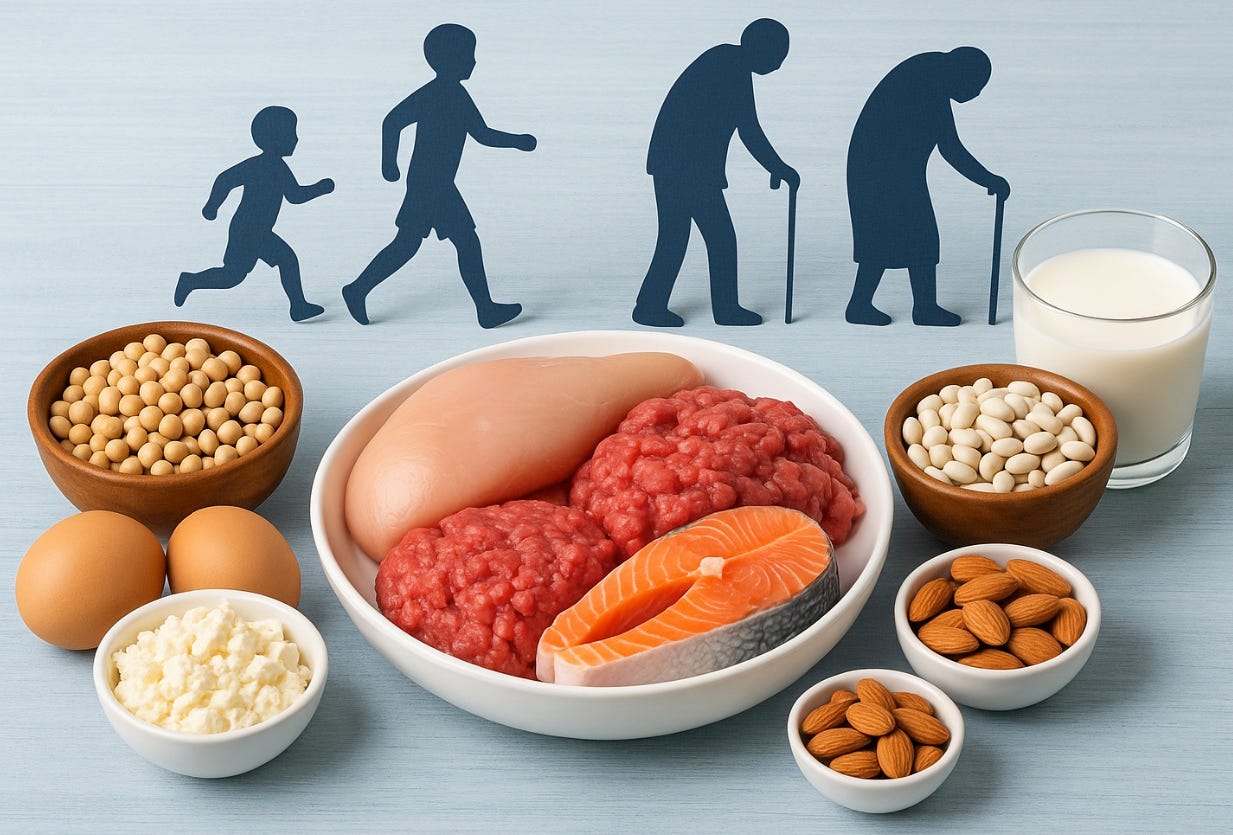Protein: The Missing Link in How We Age, Grow, and Stay Strong
Calories are not the whole story. Two people can eat the same amount, but the one eating more protein will stay leaner and stronger. With too little protein, even in a calorie surplus, the body stops building muscle and may break it down. Fat goes up, muscle goes down, and metabolism slows.
This has been shown repeatedly. Higher protein diets preserve lean mass during calorie restriction and build muscle during surplus. Without enough protein, extra calories are stored as fat. Muscle tissue is metabolically active, so losing it reduces how many calories your body burns at rest.
The effect goes beyond weight. Muscle is not just for athletes. It is the body’s protection system at every age.
Protein and kids: more than growth
Children who get too little protein build less muscle. That weakness increases the chance of falling because weak muscles mean poorer balance and coordination. When falls happen, bones are less protected because muscle normally acts as a shock absorber.
Sugar makes this worse. High sugar is not only about obesity. In many kids it means more bursts of energy, more running, climbing, and risk-taking, without the stability of strong muscles. The result is more falls and more broken bones.
Evidence supports this. A 2016 study in Bone showed that lean mass and muscle function predict bone strength in children better than body weight. A 2011 study in the Journal of Bone and Mineral Research found that children with higher muscle mass had fewer fractures, while fat mass offered no protection. Weak muscles raise both the odds of falling and the severity of injury when it happens.
Children who eat enough protein gain not just growth, but stronger muscles, better coordination, and fewer injuries.
Protein across adulthood
In early and middle adulthood, protein helps maintain strength and stable metabolism. Diets low in protein often lead to “skinny-fat” bodies, with normal weight but high fat and low muscle. Even for those who train, progress is limited without enough protein. With adequate protein, resistance training builds muscle and keeps metabolism strong for years.
Protein and aging
As people age, muscle loss, called sarcopenia, accelerates. Without enough protein, the decline is faster. This leads to weaker strength, slower walking, more falls, and greater disability.
Muscle also protects bones. Strong muscles load bones and keep them dense. Weak muscles fail to do this, so bones become fragile. They also protect joints by stabilizing them and reducing excess stress. When muscles weaken, joints are less supported, which contributes to pain, stiffness, and a higher risk of joint problems such as osteoarthritis.
Older adults with low protein intake face higher risk of fractures, joint issues, and slower recovery from illness or surgery.
A meta-analysis in the American Journal of Clinical Nutrition found that higher protein intake preserved muscle mass in older adults. A review in Clinical Nutrition linked low muscle mass directly with more falls, fractures, and higher mortality.
How much protein do you need?
The RDA (Recommended Dietary Allowance) of 0.8 g per kilogram of body weight per day only prevents deficiency. It is not optimal. Research shows higher intakes are needed for health and strength at every age.
Children (ages 4–13): 1.0–1.2 g/kg/day. Example: a 30 kg (66 lb) child needs 30–36 g/day.
Teenagers (14–18): 1.2–1.5 g/kg/day. Example: a 60 kg (132 lb) teen needs 72–90 g/day.
Adults (19–59): 1.2–2.0 g/kg/day. Example: a 75 kg (165 lb) adult needs 90–150 g/day.
Older adults (60+): 1.2–1.6 g/kg/day to slow sarcopenia. Example: a 70 kg (154 lb) older adult needs 85–110 g/day.
The bottom line
Protein is not just fuel. It is the material your body uses to build and protect itself. For kids, it supports balance, bone strength, and injury prevention. For adults, it maintains strength and metabolism. For older people, it protects independence.
A simple rule:
Multiply your body weight in kilograms by 1.2 to 2.0.
That number is your daily protein target in grams.
Spread it across meals. Give your body what it needs to turn calories into strength instead of weakness.
We hear endless health advice — complicated supplements, restrictive diets, miracle routines. Most of it changes with the trend of the year. Protein is different. It is one of the simplest, most researched, and most effective ways to prevent the decline that lowers quality of life. Stronger muscles mean fewer falls, healthier bones, more stable joints, and more years of independence.
Fact check
RDA vs optimal intake: 0.8 g/kg/day prevents deficiency but is not optimal (Institute of Medicine, 2005).
Higher intakes preserve muscle: 1.2–2.0 g/kg/day recommended for adults, especially with training (Curr Opin Clin Nutr Metab Care, 2011).
Older adults need more: 1.2–1.6 g/kg/day slows sarcopenia (Clin Nutr, 2016).
Children: 1.0–1.5 g/kg/day during growth (Dietary Reference Intakes, NAS/IOM; Am J Clin Nutr, 2015).
Muscle and bones in kids: Lean mass predicts bone strength, protects against fractures (Bone, 2016; JBMR, 2011).
Low muscle → falls: Weakness linked to poorer motor control and higher fall risk (Dev Med Child Neurol, 2012).


